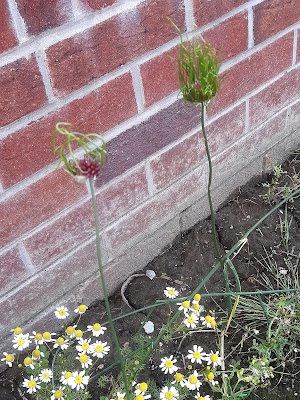This was the scene that greeted us a couple of weeks ago when I took Son the Younger up the meadow with the promise of views all the way down to the wind turbines and the coal chute at Avonmouth, near where he works.
And the sunset on the longest day of the year looked like this.
At least there's water in the ditches now.
When the longer view isn't so great, I find myself focusing on stuff that's under my nose and that I might otherwise have missed ...
... like these poppies and cornflowers and corn marigolds ...
... and this very large, very hungry cabbage white caterpillar, munching on honesty ...
... and this greenbottle ...
... and these rose chafers, both on hogweed.
And just look at the colours of this - a five-spot burnet moth on vetch. Just amazing.
The etymology of 'burnet' is Middle English 'a dark brown woollen cloth', which is a bit perplexing.
Here's another lovely: daucus carota, also known as wild carrot, bird's nest, bishop's lace and Queen Anne's lace. (You can tell it by the single red flower near the centre of the umbel, which is there (though not always) to attract insects.) (And is also blood from the lace-maker's pricked finger, obviously.)
Different stages of hogweed setting seed
I've also learnt some new-to-me flowers with wonderful names. This is hedge woundwort, with my favourite moon daisies ...
... and marsh woundwort.
And here's marsh woundwort with ... well, for a while I didn't know what this red globular onion-y plant was. I just took some photos and decided I'd look it up when I got around to it.
But then the very next day my cousin, 3000 miles away in New Jersey, posted a photo of the same plant on Facebook. (She didn't know what it was either.) And the next day Mitch, just outside Bath, did the same, only she could identify it - Allium vineale, or crow garlic.
How strange, I thought, to have been unaware of it all my life and suddenly it's pimpling the edges of the playing field, and infesting my timeline.
On Saturday I spotted some in my front garden. 'It's everywhere!' I wailed to my cousin. 'It must be the triffid component to Covid-19. It's going to wait until everyone of us is weakened and immobile and then it's going to eat us.'
Yesterday I realised they weren't strays in my garden at all, but scouts reporting back to a garrison of the stuff stationed at the end of the road ...
... wild-haired as a result of the lockdown and sending urgent messages ...
Deadly nightshade and the witchy whitethorn of the fairway
It's a shame that the moment the Northerner finished his coursework, the football started up again, but with the weather set to change back to sunny summer days, hopefully there'll be a few more TED Walks for me and my dog.


























No comments:
Post a Comment